CAMBRIDGE, Vt. — What was once a smattering of farms offering dinners within view of the fields where the food was raised has sprouted into popular summer and fall events that run the gamut from multicourse dinners to weekly burger nights at farms across the country.
These farm feasts are popping up from California to Vermont and are part of the growing agritourism movement. Diners enjoy locally raised foods; farmers supplement their income.
“It makes you appreciate farmers in a different way. And you can’t beat the food,” said Barbara O’Connell, of Ardsley, New York, who with her family recently attended a farm dinner for a second year in a row at Valley Dream Farm in Cambridge, Vermont.
They were among the 60 people seated on hay bales around two long tables on the farm stand’s open-air porch on a clear hot evening. A neighbor’s cows chomped on grass across the road, and an occasional truck passed by on the rural road pulling trailers of freshly cut hay.
The feast included a salad of lettuces, kale and blueberries; maple mustard chicken; tiny new potatoes; grilled zucchini and summer squash; and homemade vanilla ice cream with maple syrup. The dinner – $65 for adults, $39 for children under 10 – came after a hay wagon tour of the lush green fields where the organic produce is grown.
At least five farms now offer regular farm dinners in Vermont. Farm dinners also have grown in the Midwest, said Bob Benenson, spokesman for the nonprofit FamilyFarmed, which works with farmers and food entrepreneurs to help grow their businesses.
“By using these dinners to draw people down to a farm, it serves to educate them, enlighten them more about sustainable agriculture practices and hopefully, at the end of it, they go back to wherever, Chicago, the suburbs, and they start shopping more at farmers markets and things like that,” he said.
Kruger’s Farm in Portland, Oregon, couldn’t survive on farming alone, said its president, Don Kruger.
“I’m telling you, just farming doesn’t make it. You got to do everything else to make things work,” said Kruger, whose farm serves meals to patrons under a 300-year old oak tree with a huge canopy.
“I think when people come to farm-to-plate dinners they’re really supporting the farm. I mean it’s getting farms a chance to make a living,” he said.
Diners generally must preregister, and many of the farms don’t have liquor licenses. Customers can bring their own bottles of wine or beer at some. Farms that do offer booze or pairings of wine or beer with meals are pricier; one starts at more than $200 per person.
The dinners can also be culinary feats. Granor Farm in Three Oaks, Michigan, has started running periodic weekend meals this summer. A recent menu included coddled egg with garlic scapes, mushroom cream sauce and frybread; and brown butter and pork belly with wheat berries, rhubarb and fennel.
A multicourse meal costs $75. The 16-person dinners, which run until November, sold out in July.
“We are seeing repeat customers,” said Chef Abra Berens, who said the farm is hoping to expand the dinner events to other seasons. “The best compliment I’m getting is that a group will come to a dinner and then book several dates later in the season.”
Send questions/comments to the editors.



